Reflections on the South African GP
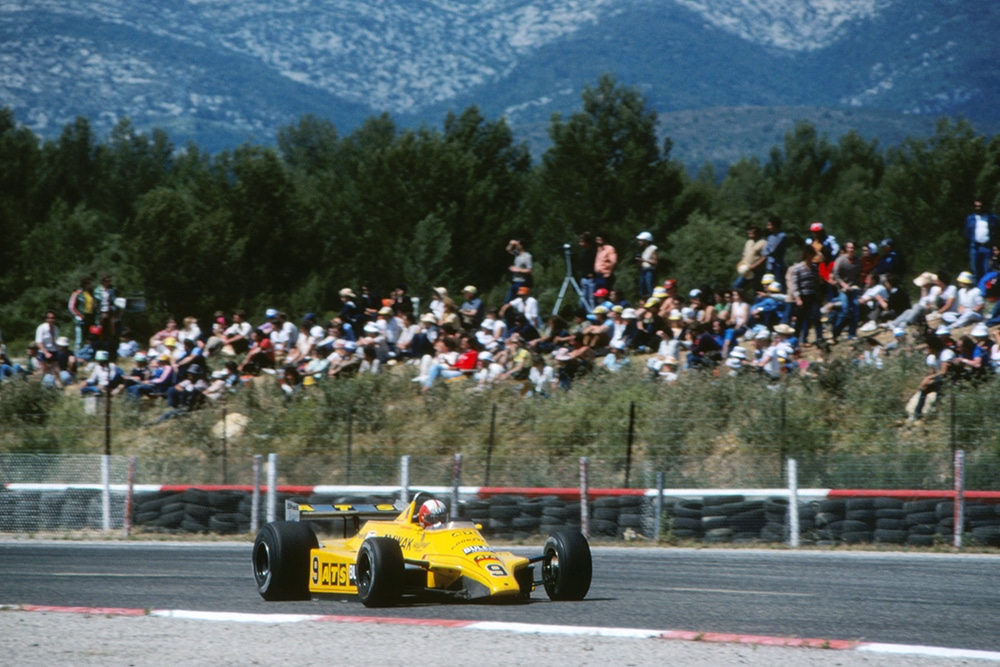
Marc Surer in a ATS D4 made his first GP appearance since breaking his ankles at the South African GP.
© Motorsport Images
While the 1980 South African GP was not one of the most exciting to watch, and even less exciting to see in virtual silence on television, there was much to be learnt from it. To watch those two Renaults cruising round in formation, in total domination of the race, was to see the real reason why a big manufacturer takes part in Grand Prix racing. When a manufacturer reaches the state of domination that Renault reached in South Africa, they reap the benefits of all the time, money, effort and engineering they have put into their racing team. As those two cars droned relentlessly round the Kyalami circuit you could not fail to realise what a fantastic publicity and advertising campaign it represented for the Regie Renault. Every Renault owner from humble R5 to V6 Saloon, must have thought “Man, look at those Renault cars, aren’t they something” and for weeks afterwards he would be more proud of his own production Renault than ever before. As we all know, when deciding on a new car we invariably ask a friend or acquaintance who has a car similar to our choice, so that he can get first-hand confirmation that we have made the right choice. After that demonstration at Kyalami the Renault customers already committed most have influenced a lot of people that Renault was the car to buy. No matter that the RE Formula One cars have little resemblance to a road car, it’s the name that counts. “Man, did you see how those Renaults went at Kyalami”.
Teams that have no connection with the outside world or are sponsored by household consumables don’t carry the same impact. If Tyrrell had won the race no-one would have said “Man, didn’t those Candy Appliances go well” or if Brabham had won no-one would have said “Man, that Parmalat Food is really good. It beat everyone at Kyalami”. The best that the sponsor’s advertising manager can hope for is that the name Candy, Parmalat, Marlboro, Gitanes, Villiger or whatever else is on the car, will have been imprinted on the spectator’s subconscious, so that when he or she goes shopping they may see the sponsor’s product and buy it for want of knowing any other similar products. From this aspect it doesn’t much matter whether “Double-dab soapflakes” are on the car that is leading or the car that is last, as long as it is circulating. A travelling bill-board to brain-wash the consumer. With Renault the impact is practical and real, for Renault engineering is being demonstrated loud and clear. Do not forget that it is Motor Racing we are talking about, which is the business of racing motorcars, not racing cigarette packets, soap powder, beer bottles or any other consumable.
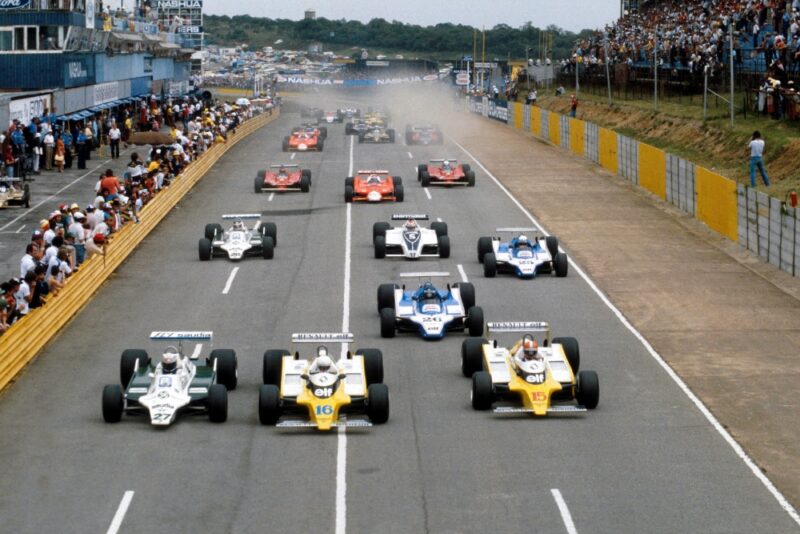
L-R at the start – Alan Jones (Williams), Rene Arnoux (Renault) and pole sitter Jean Pierre Jabouille (Renault).
© Motorsport Images
Already we have four production manufacturers competing with works teams, Ferrari, Lotus. Renault and Alfa Romeo, and next year Talbot are joining in. A lot of people bemoan this fact, saying it will outprice the small teams, and is a bad thing for the future of the sport. I say it is a good thing and will bring reality to Formula One. The very top echelon of motor racing is not the place for amateur teams, and teams like ATS, Shadow, Arrows, Osella and one or two others are not really in the right league. The same applies to sports car racing and Le Mans in particular: the great days of the 24 hour race were those of Jaguar, Aston Martin, Mercedes-Benz, Ferrari, Porsche, Ford and so on. Nobody will remember the doldrum days of the sporting amateur and his obsolete car, it is the battles between manufacturers that we remember. In Formula One. or Grand Prix racing, it is the same.
I am a great believer that an engineer worth his salt understands the meaning of the word integrity, both in a design sense and as a manner of conducting oneself. The Public Relations world and the advertising world, and even the big business world, get along with a fair measure of “bullshit”, but engineers have no need for it; indeed it is anathema to any competent engineer. On the tyre front Goodyear and Michelin engineers agreed last November that special super-sticky qualifying tyres were a blind alley they could do without. While the FISA and the FOCA were dickering about in Committee, Goodyear forced the issue from the beginning of this season by eliminating the qualifying tyre from their racing programme. At Kyalami Renault gave them full support by driving all their practice on tyres suitable for the race. A breath of fresh air in the confused atmosphere of Formula One.
After the race all the finishers were directed into a compound and all the cars were weighed and checked for certain important dimensions. While the rest of the racing world was fussing around the drivers, both victorious and defeated, most of the engineers were gathered around the weighbridge, watching their own cars being checked and checking on their opponents. Weighing cars during practice or before a race is rather a pointless exercise as conditions are so unstable, and the “smart Alecs” can easily cheat or confuse the issue. As a car has finished a race is about as honest a check as you can get, apart from how much petrol is left in the tanks. Most of these engineers gathered around the weighbridge were in agreement that they would not start a race with more petrol in the car than was absolutely necessary, so they would all have about the same percentage left at the end of the race. The weights recorded were most interesting and caused a few whistles of amazement in some cases.

First corner and Jean-Pierre Jabouille (Renault) just out of the picture, is followed by eventual winner Rene Arnoux also Renault, right and Alan Jones (Williams).
© Motorsport Images
Here are the weights, in Kilogrammes, just as they finished the races:—
No 3 Tyrrell 010/1 (Jarier) 581 Kgs
No 5 Brabham BT49/4 (Piquet) 592 Kgs
No 14 Ensign MN11 (Regazzoni) 593 Kgs
No 11 Lotus 81/2 (Andretti) 595 Kgs
No 28 Williams FW07B/5 (Reutemann) 597 Kgs
No 20 Fittipaldi F7/1 (Fittipaldi) 597½ Kgs
No 6 Brabham BT49/5 (Zunino) 598 Kgs
No 7 McLaren M29/1B (Watson) 605 Kgs
No 30 Arrows A3/4 (Mass) 608 Kgs
No 25 Ligier JS11/15/04 (Pironi) 612 Kgs
No 26 Ligier JS11/15/03 (Laffite) 629 Kgs
No 16 Renault RE21 (Amoux) 639 Kgs
No 22 Alfa Romeo 179/003 (Depailler) 662 Kgs.
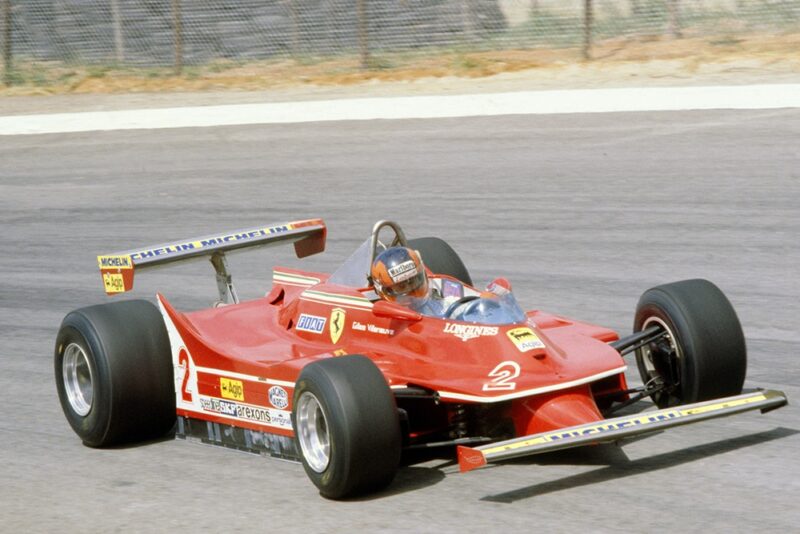
Gilles Villeneuve at the wheel of his Ferrari 312T5
© Motorsport Images
Surprises were the light weight of the Tyrrell 010, the medium weight of the Williams, the great weight of the Ligiers and the unbelievable weight of the Alfa Romeo, but as Depailler had only done 53 laps of the 78 lap race his car was probably holding more petrol than anyone else. If the Autodelta V12-engined car really does carry that handicap then the engine must be pushing out quite a lot of horsepower. The weight of the Renault was no surprise, with its two turbo-charger units, inter-coolers, and pipe-work.
On the political and financial front the South African GP was well up to standard for this day and age. Last year certain races, notably the Brazilian GP, the Spanish GP and the German GP were involved with some heavy financial manipulations conducted by the ever-smiling flaxen-haired Max Mosley. Many people got the wrong impression, thinking that the Formula One Constructors Association (FOCA) were involved. Certain FOCA people were involved but not wearing their FOCA hats. Details are difficult to come by, but the gist seems to be that a group of German bankers, who are friends of Max Mosley, operate an International Banking business from Geneva. In effect, they provided the capital to put on the races mentioned above, and took the profit or loss, their interest not being in each individual race. but the season or year as a whole. If Brazil lost money and Germany made money all they were worried about was the profit overall. This took the financial burden off the organising club, but rest assured it was not as simple as it seemed, it involved lots of other manipulations.
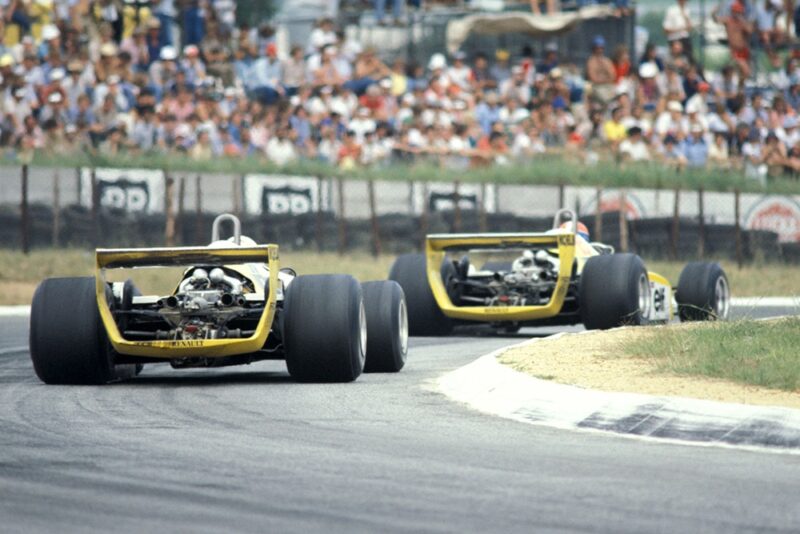
Jean-Pierre Jabouille in his Renault RE23 leads team mate and race winner Rene Arnoux, in a Renault RE21.
© Motorsport Images
Now it seems that this banking group, advised by Max Mosley, has purchased the Kyalami circuit, or at least the ground on which the circuit stands. The South African Motor Racing Club were paid with a cheque on a New York bank, which was quite sound and this removed a big financial burden and risk from their shoulders. With Mosley being directly involved in the financial success or failure of a race he becomes very conscious of some non-profit making aspects of the normal scene. In the shadow of the tall and elegant Mosley lurks little Mr. Ecclestone who handles all the financial dealings on behalf of the FOCA members, so the two of them have a pretty tight hold on the purse strings of some Formula One races, and they would like to hold more.
Last year Television companies, especially commercial ones, were charged big money by the Mosley/Ecclestone group for the favour of televising Formula One, and once or twice Radio stations were pressured to pay money for broadcasting. In South Africa all the radio stations were charged big money if they wanted to do a direct broadcast. When the BBC heard that they would have to pay some hundreds of pounds to the “Max and Bernie show” for Simon Taylor to do a broadcast for Radio 2 they told Taylor to forget it and not bother to go to South Africa. “M & B” relented, because the BBC is non-commercial, and Taylor was allowed to broadcast for nothing. A local Johannesburg radio station also fell foul of “M & B”. They paid their broadcasting fee, as requested, as they are a commercial radio programme, but when they were asked for another big bag of gold for the advertising balloon they proposed to fly from the infield they baulked. They were told that if they didn’t pay up, or remove the balloon, their radio link would be cut, even though they had paid their broadcasting fee. At this they ran a recording explaining to their listeners why their race broadcast was not happening, and told “M & B” that if the link was cut they would run this recording every 15 minutes throughout the Grand Prix. Rather than pay the balloon-flying fee they took it outside the circuit and flew it from a nearby field. After a lot of “argy-bargy” the radio station won the battle and were asked to fly the balloon from inside the circuit for nothing, as it looked bad having it in a neighbouring field, and their radio link was not cut!
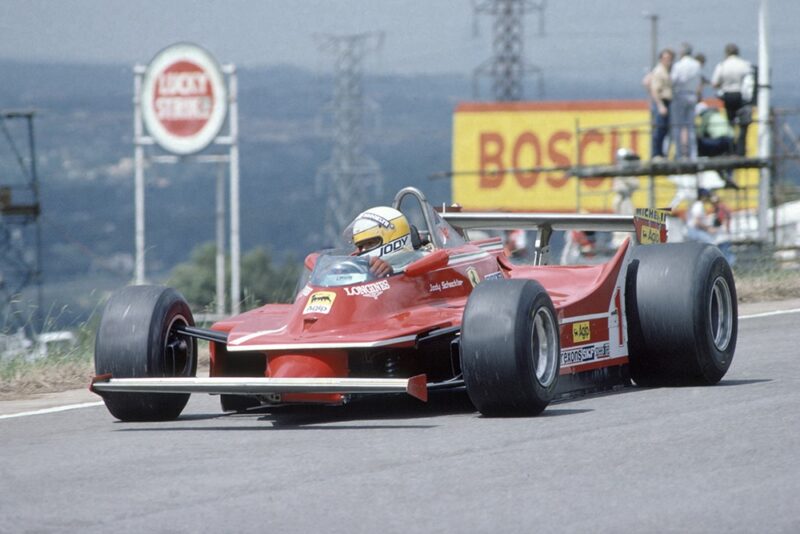
Jody Scheckter driving a Ferrari 312T5
© Motorsport Images
Very noticeable around the circuit were a number of big advertising hoardings that were completely blank. These were firms who jibbed at the huge increase in fees demanded by “M & B” and rather than pay up they withdraw their advertisement. It is now only a matter of time before “M & B” turn their attention to the Press and demand money for reporting races. When that happens Motor Sport will carry blank pages and you will know who to blame. Formula One is undoubtedly a world-wide money-spinner and a Golden Goose that lays big fat golden eggs, but a goose is easily killed by greed, either self-inflicted or assisted.
Biggest joke of the political scene at Kyalami was when Mosley asked for all the portable grandstands to be removed, the aim being to force people to buy grandstand tickets. The excuse given was that some of them were dangerously constructed and could collapse onto the circuit and cause an accident! A gang of labourers went round the circuit during practice dismantling any unoccupied scaffolding stands, but in some places the owners of builders defied the directive and “sat-it-out” twenty or thirty feet up in the air. One builder was said to have produced a “certificate of worthiness” for his structure. On race day there may not have been as many portable stands as last year, but it wasn’t noticeable.
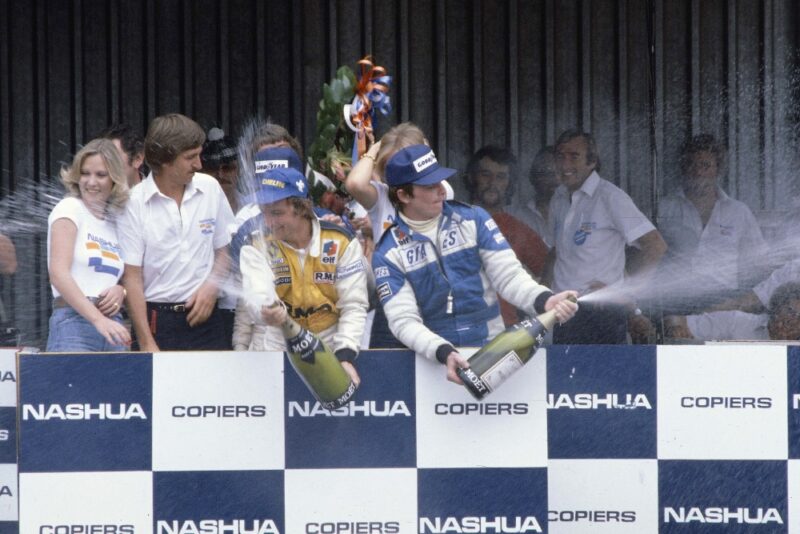
Rene Arnoux (Equipe Renault) celebrates his 1st position on the podium with Patrick Depailler (Ligier Ford) 3rd position.
© Motorsport Images
Still on the non-racing scene the newly formed Grand Prix Drivers Association, which Scheckter is trying to rule like Stewart did before him, got themselves in a muddle over the FISA ruling that “skirts” were to be banned from January 1st 1981. Scheckter has been supporting the idea (prodded by Ferrari, because the T4 and the T5 have never been very strong on ground effects) but Jones, Watson and Piquet were in opposition. While Frank Williams openly admits to putting pressure behind Alan Jones, there was not the same openness from Teddy Mayer or Bernie Ecelestone. The outcome was that Alan Jones told Scheckter what he could do with his GPDA, in good Australian terms. Scheckter’s team-mate, Villeneuve, says quite simply “I am too occupied trying to win motor races to become involved with the GPDA and political issues”. Not a good Union man, young Villeneuve, much too interested in his job!
There is seldom a dull moment at a Formula One race. — D.S.J.
